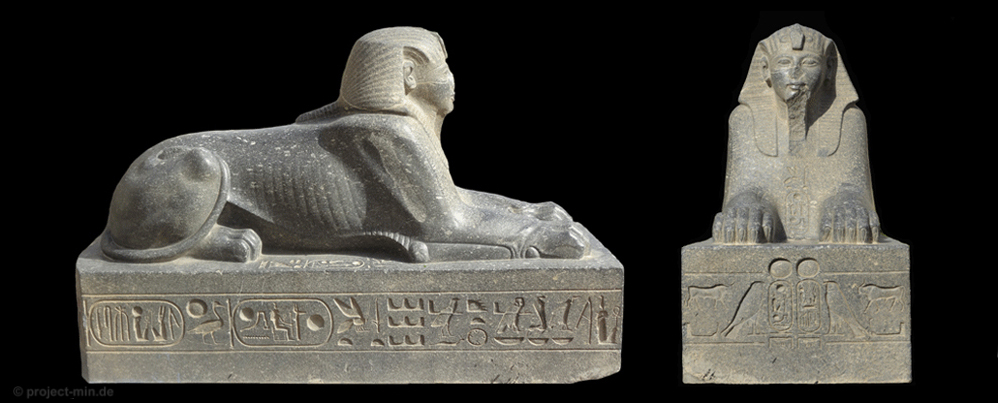M.i.N. Museen im Nildelta - Museums in the Nile Delta
The Museum at Ismailia
The museum was built in 1932 to house the numerous antiquities discovered while digging the Suez canal (1859-1869). During the construction of the sweet water canal, which leads from the river Nile to the Suez Canal, a portion of the ancient settlement of Tell el-Maskhuta (Pithom) was unearthed and statues from the ancient temple of Atum emerged. Over the time more artefacts were included from different sites so that the Museum today offers an overview on the cultural history of Egypt from the Early Dynastic Period through to the Islamic Era.
Exponate aus Tell el-Maskhuta
Tell el-Maskhuta, the ancient city of Pithom ("House of Atum"), is situated at the Wadi Tumilat. On this site during Dynasty 26, the pharaoh Necho II (610-595 B.C.) started digging a canal to connect the Nile with the Red Sea. This immense task was completed much later under the Persian king, Darius I (522-486 B.C.), an event confirmed on the so-called canal stelae. The importance of Tell el-Maskhuta has been known since 1883 when the site was excavated by the Swiss Egyptologist Edouard Naville. The number of objects found by him was later added to by the French archaeologist Jean Clédat who worked at Tell el-Maskhuta in the early years of the 20th century.
The finds from Tell el-Maskhuta include the statue head of a Libyan official, who lived during Dynasty 22. It was made of dark red, silicified sandstone. A priest is shown wearing a bipartite wig, finely detailed with echeloned curls, and topped by a large scarab in high relief. The inscription on the back pillar identifies the head as that of the priest of the goddess Bastet Wa-ka-ra-men. He played an important role in the nearby ancient city of Bubastis. The head is a rare example of the sculptural school of Lower Egypt during that period.
Another highlight of the museum is the nearly intact sphinx at the entrance to the museum, which bears the name of the pharaoh Rameses the Great (top). But closer examination proves it is of much earlier date and was one of the famous maned sphinxes of king Amenemhat III (Dynasty 12, c. 1853-1806 B.C.) More of these can be seen at the Egyptian Museum at Cairo. After almost 600 years it was altered to become a portrait of the youthful king Rameses II (1279-1213 B.C.). Traces of this remodelling are still clearly visible.
(click on the pictures to enlarge them)
Artefacts from other sites
Along both sides of the exhibition room stand display cases filled with smaller objects dating from the Middle Kingdom to the Ptolemaic Period. One of the most impressive items is a rather unusual votive stela dating to the Late Period (Dynasties 26-30, c. 664-342 B.C.) that was discovered in the so-called 'cachette' in the great temple of Amun at Karnak in Upper Egypt. Its iconography is reminiscent of statues of the Predynastic and Early Dynastic Periods. Instead of a mummiform shape, the god Osiris, ruler of the Netherworld, is shown wearing a simple loincloth and penis-sheath. On top of his tripartite wig he wears the so-called atef-crown adorned with ram's horns and ostrich feathers. The well-preserved block statue of Ankh-ef-en-Khonsu, priest of Amun at Karnak, was found at the same site. It dates to the early Ptolemaic Period (around 300 B.C.) and had been set up at the temple of Karnak.
The Ismailia Museum, in addition to its displays of the pharaonic period, also has a rich collection of Hellenistic and Roman art. There are fine Greek marble statues of heroes and divinities such as Aphrodite, life-sized portrait heads of Roman nobles including one of the Emperor Marcus Aurelius and notable examples of small statuary. Also represented are bronze figures of the pharaonic Late Period and objects relating to the minor arts, ranging from the first millennium B.C. through to the Roman, Byzantine, and early Islamic periods. Particularly striking is a group of blue, green or white, iridescent glass vessels.
Without doubt, the largest and most significant Roman exhibit is the floor mosaic of the 3rd century A.D. This dominates the gallery and portrays tragic episodes relating to figures such as Ariadne, Theseus, Phaedra and Hippolytos along with more lively and colourful scenes, like the "Triumph of Dionysus". In late antiquity Dionysus, the god of wine, known as Bacchus to the Romans, became a popular divinity who promised his followers abundant enjoyment and revelry not only in this world but also in the afterlife.
Also noteworthy and not to be missed are the well-preserved mummy masks (above, at the top of this page), which are painted and partly gilded. Of Roman Imperial Period date, they combine traditional Egyptian funerary iconography with stylistic features of Hellenistic and Roman art - a cultural blend characteristic of Egyptian late antiquity.






















